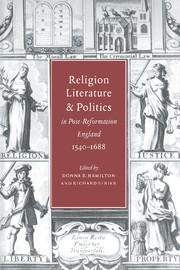Book contents
- Frontmatter
- Contents
- List of contributors
- Introduction
- 1 Sir John Oldcastle as symbol of Reformation historiography
- 2 The “sacred hunger of ambitious minds”: Spenser's savage religion
- 3 Subversive fathers and suffering subjects: Shakespeare and Christianity
- 4 Kneeling and the body politic
- 5 Donne and the politics of devotion
- 6 Catholic, Anglican or puritan? Edward Sackville, fourth Earl of Dorset, and the ambiguities of religion in early Stuart England
- 7 Crucifixion or apocalypse? Refiguring the Eikon Basilike
- 8 Marvell, sacrilege, and Protestant historiography: contextualizing “Upon Appleton House”
- 9 Entering The Temple: women, reading, and devotion in seventeenth-century England
- 10 Contextualizing Dryden's Absalom: William Lawrence, the laws of marriage, and the case for King Monmouth
- 11 Reformation in the Restoration Crisis, 1679–1682
- 12 Shadwell's dramatic trimming
- Index
4 - Kneeling and the body politic
Published online by Cambridge University Press: 16 October 2009
- Frontmatter
- Contents
- List of contributors
- Introduction
- 1 Sir John Oldcastle as symbol of Reformation historiography
- 2 The “sacred hunger of ambitious minds”: Spenser's savage religion
- 3 Subversive fathers and suffering subjects: Shakespeare and Christianity
- 4 Kneeling and the body politic
- 5 Donne and the politics of devotion
- 6 Catholic, Anglican or puritan? Edward Sackville, fourth Earl of Dorset, and the ambiguities of religion in early Stuart England
- 7 Crucifixion or apocalypse? Refiguring the Eikon Basilike
- 8 Marvell, sacrilege, and Protestant historiography: contextualizing “Upon Appleton House”
- 9 Entering The Temple: women, reading, and devotion in seventeenth-century England
- 10 Contextualizing Dryden's Absalom: William Lawrence, the laws of marriage, and the case for King Monmouth
- 11 Reformation in the Restoration Crisis, 1679–1682
- 12 Shadwell's dramatic trimming
- Index
Summary
If we examine theological debates from 1603 to 1625, we find James I ruled over a better reformed church than did either his predecessor or his successor. If we consider ecclesiastical enforcement in the same period, we find James I ruled over a better conformed church. In fact, recent scholars have all but eliminated every possible point of contention that might have divided the Jacobean church, and still we know that James's was not an entirely reformed, quiet, nor contented religious settlement. When we analyze the rhetoric of religion in the early seventeenth century, then we find that James I ruled over a powderkeg.
Both the evidence for and the source of this problem can be found in the polemics of the early Stuart church. Without question, James I managed a religious settlement that was remarkable in this age for its theological consensus and non-confrontational policies. But it is also true that he did so while always tolerating and often encouraging an official rhetoric of scorn and contumely against papist and puritan subjects who placed themselves outside the generous bounds of that settlement. In the case of puritanism, this was particularly destabilizing: unlike papists, puritans were a distinctive phenomenon contained for the most part within the Church of England. The official language of the church was thus set against puritan experience.
- Type
- Chapter
- Information
- Publisher: Cambridge University PressPrint publication year: 1996
- 3
- Cited by



